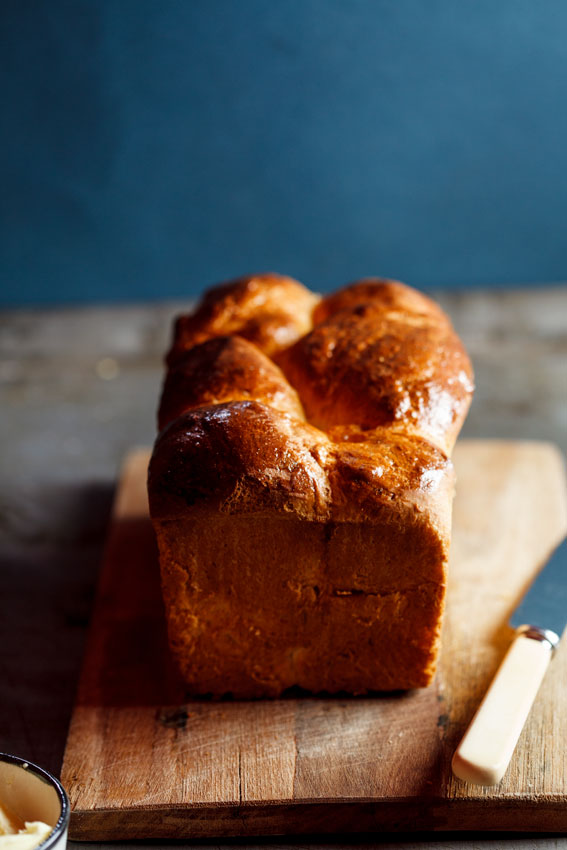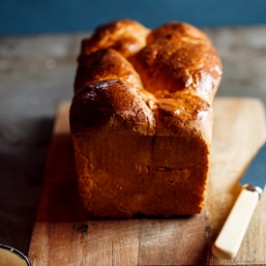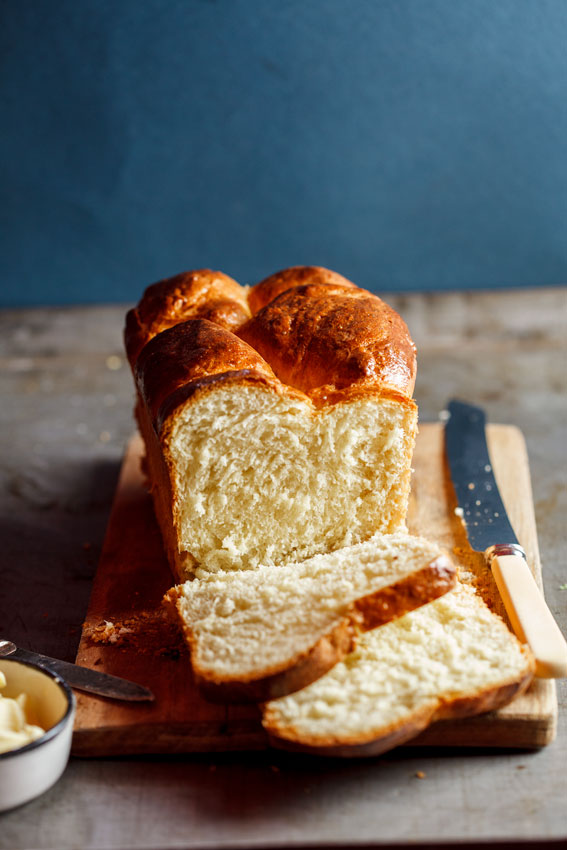Brioche loaf
Baking your own brioche takes a little effort but it is so worth it. Light and buttery with a pillowy interior. The leftovers are perfect for French toast.

When I first started baking bread, brioche was the one thing I found completely daunting. I feel the same way about brioche as I do about croissants. I love eating them but I don’t want to make them myself. But let me tell you, homemade brioche is a thing of absolute beauty. Bubble-topped and begging to be sliced into. As you slice into the still-warm loaf, you’ll be met with a burst of steam with the aroma of butter and yeast. Drool-worthy stuff, I tell you. It’s also obvious at that moment that all the hard work is completely worth it. I’ve made this loaf over and over again and I can tell you, it’s delicious every single time.
All my tips and tricks to make the perfect brioche can be found below the recipe.

Table of Contents
Brioche loaf
Ingredients
- 125 ml warm milk
- 3 tablespoons/70g sugar
- 10 g dried yeast
- 4 eggs
- 500 g flour
- 2 teaspoons salt
- 175 g butter cubed (remove the butter from the fridge 30 minutes before you want to start. Butter needs to be slightly soft.)
- 1 egg beaten (for egg wash)
Instructions
- Combine the milk, sugar and yeast in the bowl of a free-standing mixer and allow to stand for 5 minutes until the mixture is creamy and start to froth slightly.
- Add the eggs and beat well until the eggs are well incorporated and the mixture is light and creamy.
- Slowly add the flour and salt with the mixer running until the flour has been incorporated.
- Allow to knead at medium speed for a minute.
- Slowly add the cubes of butter and knead for another 5 minutes.
- The dough will begin to pull away from the sides of the bowl and will cling to the paddle.
- Remove the dough and place in a buttered bowl.
- Cover with clingwrap and allow to rise for 2 hours.
- Place in the fridge and allow to stand overnight.
- The next day, remove the dough from the fridge and allow to come to room temperature.
- Divide the dough in half and place in greased loaf tins.
- Allow to rise for another 2 hours.
- Pre-heat the oven to 180°c. Brush the loaves with the egg wash.
- Bake the loaves for 40-45 minutes until the loaves are golden brown and sound hollow when tapped.
- Remove from the oven and allow to cool.
Tips for making the best brioche bread
- Making brioche can seem overwhelming but my number one tip is to use a stand mixer fitted with a dough hook. Letting the machine do the kneading for you makes this a breeze and gives you control to manipulate the dough. However, this recipe is 100% doable by hand.
- Combine warm milk(blood temperature – if you stick your finger into the milk it should feel almost like nothing. That means it is body temperature), sugar and yeast in the bowl of a stand mixer. Allow to stand for 5 minutes until frothy. This step activates the yeast and gets it going.
- Once the eggs, flour and salt is added, knead the dough for a minute or two until everything is well incorporated.
- Slowly start adding the butter, bit by bit, until it too is incorporated into the dough. At this point the dough might seem very sticky but continue kneading until the dough starts to come away from the sides of the bowl. If it doesn’t and it is still very wet, simply add 2-3 tablespoons of flour, one at a time, until the dough firms up a little. The flour will also continue hydrating as it rises.
- Cover the dough with plastic wrap then allow to rise for 2 hours at room temperature. After that, place it in the fridge overnight. This step is crucial as this slow fermentation builds loads of flavor.
- Once ready to bake, remove the dough from the fridge and transfer to a clean, greased bowl and cover with a damp tea towel. Allow to come up to room temperature.
- Break pieces of dough (approximately the size of tennis balls) off and form into rough balls. Place into 2 lined loaf pans then cover again with the damp tea towel and allow to rise while you allow the oven to preheat.
- Brush the loaves with beaten egg and place in the oven. Allow to bake until puffed and golden. Remove from the oven and if you can resist temptation, allow to cool before slicing.

Bread recipes
- Rosemary Pecorino Potato bread
- Cheese and herb Irish soda bread
- Easy garlic butter dinner rolls
- Homemade ham and cheese crescent rolls

Hi! I’m considering making this recipe into loaf since I have 30cmx12cm tin. Would that work? What is the approximate baking time if so? Thanks!
It should, I would bake it for at least 45 minutes and then check it every 10 minutes from there.
Hi. If you doing this by hand, how long does one need to knead the dough?
Probably around 5-10 minutes until you have a very smooth dough.
The leftovers are super perfect for French toast!!!! Thanks for recommending <3
Please correct the total time needed for this recipe. By my calculations, just using the time references called out in the recipe (skipping the actual time to do work,) I calculate the total time minimum to be nearly 14 hours, not “1 hour 20 mins.”
Hi Drew. I only include the time you’ll be actively busy with a recipe. I encourage readers to read the full recipe before starting so to see what equipment they need and how much time they need to allow for things like dough rising, etc. I will however add a note at the top of the recipe to allow time for the dough to prove.
Hi,
I’ve had terrible luck making bread but this seemed easy enough so I tried it. First off, i ended up with a batter, not a dough. I added a bit more flour but I didn’t want it to be dry so it was extremely wet and sticky. I proved it and it seemed to have tightened up, but when I went to knead and shape it, it was still a wet mess. I proved and baked it as directed. It had a delicious taste but was VERY crumbly. What could have gone wrong? Want to try again because it tasted really good. Thanks!
The dough is meant to be very soft and sticky. It’s definitely not like any other bread dough, however it should also not be as completely wet as a pancake batter for instance. A wet/sticky dough gives you a very soft loaf which is why brioche is so light and buttery inside. The fact that yours was crumbly is very confusing to me. I actually have no idea what could’ve gone wrong there, to be completely honest. I’ll try to Google a bit to see what could’ve happened there and will get back to you.
I appreciate it! Thanks in advance!
Can I use this recipe for chocolate roll brioche. Does it freeze well?
I’m sure you could. To be honest, I’ve never frozen this recipe and am not sure how it will freeze due to the amount of butter? However, after a quick Google it seems you can freeze brioche dough. I would remove it from the freezer the night before you plan on baking it to give it efficient time to defrost.
Can I make chocolate filled Brioche using the same recipe and can I make a day ahead to be served for the party?
I’m sure you could! I would make the dough a day ahead but then bake it on the day you intend on serving it.
Hmm I am confused. You state to leave the dough in the oven overnight and then in the next step you say to remove it from the fridge and let come to room temp. So can you just overnight it in the oven with the light on or do you want the slower cold rise by putting it in the fridge overnight? Also do you smooth the sought balls together or do they manage to do that on their own during the last rise and then in the oven? Thanks!!
Completely my mistake, I’ve amended it. THe dough rests in the fridge overnight for slow fermentation. The dough balls bake into one loaf so no need to press them together.
Thank you so much for the clarification!
This looks great! Two quick questions – do you is a dough hook or just the regular paddle with your mixer and how long do you leave it out to get to room temperature – 1 hour? Thanks!!
I used the dough hook and yep, around 1 hour should do the trick.
hi alida can I use butter flavoured crisco ( vegetable shortening) and soy milk / almond / coconut milk ? my baby can’t have dairy. also what does ” sound hollow when tapped ” means ? i know this is a stupid question, how do i tap it ? once i baked a brioche loaf, checked with a skewer inserted, which came out clean, but the loaf collapsed as the centre was not cooked (right in the middle). many thanks
You could but I’m not sure it will alter the texture of the loaf, you’ll have to experiment with it. The thing with bread is that because the dough is quite stiff, there’s nothing for the skewer to cling to so it could be raw even though the skewer comes out clean. If you upend the baked loaf and tap on the bottom, there will be a hollow sound if the bread is cooked through.
Hello! Just stumbled on this recipe. Stupid question, but since you were using a stand mixer, did you use the standard paddle attachment or the dough hook?
Thanks!
I used the dough hook, and not a stupid question at all!
Do you, by any chance, have this in US measurements? I would love to give this a try!!
I don’t but you can try this conversion chart: https://simply-delicious-food.com/2014/03/26/conversion-chart/
I’m glad Hailey asked the question, and I hope the chart will give the answers. I realise only Americans use our weights and measures, but it would be helpful to give American alternatives we would readily understand.
2 teaspoon of salt… Is that correct?!?
Yep, because the dough is enriched with sugar, eggs and butter, the salt is needed to balance it all out. And remember, this makes two loaves or one very large loaf so that amount isn’t actually that much.
I’ve tried converting measurements to imperial. Though not exact, these are the closest I’ve come:
125ml milk = 1/2 cup (120ml)
10g yeast = 2 1/4 tsp (one envelope)
500g flour = 3 1/3 cups
175g butter = 6 oz (130g)
I haven’t tried the recipe yet, but I will do so this week.
Correction: 6 oz butter is 180g
Just wondering, what are the dimensions of the loaf tins you used?
They were around 20cmx12cm.
Does the dough have to stand over night in the fridge or can it be used after the rise .
The proving overnight improves the flavour of the dough tremendously but if you’re in a hurry, you can definitely use it right away. The flavour just won’t be as good as a proper brioche.
Hi Alida!
So you used the paddle attachment on your mixer and not the dough hook right? Dying to try this recipe! Your loaf looks amazing 🙂
No, I used the dough hook. Does a much better job of kneading than the paddle would.
Hi Alida, I’m dying to try this recipe and I’m planning on prepping the dough today. The thing is, I won’t have time to bake it tomorrow… Do you think another day + night of resting would affect the dough? Perhaps punch the dough down once or twice if it rises too much? Thanks!
Hi Annemay. So sorry for only responding to your comment now. No, I don’t think that the extra resting time will do anything to the dough. IN fact, the flavour will probably just be better!
I’m not sure if step 6 is a good description. Watched some videos and made brioche a couple of times and the brioche batter does not come off from the sides like a traditional dough. It would resemble a thicker cake batter?
Hi Elaine, thanks for your comment. I have made this brioche a few times and when the dough has been kneaded enough, it does pull away slightly from the bowl. It could just be my dough? When I make it again I’ll make sure to check out for that and will amend the recipe if I find that it doesn’t pull away.
i read in the comments that you used bread flour but do you think all purpose flour will work as well?
Yana, all purpose flour doesn’t have as high gluten content as bread/strong flour. You need the gluten to create the texture you’re after when you’re baking bread, but especially brioche. But of course you could give it a go, it might just be slightly softer? Let me know if you do try it how the brioche turns out.
In Canada you can use AP flour as our flour is different from American flour. Anyone serious about baking should learn to weigh their ingredients for accuracy. You can get an inexpensive digital scale at any kitchen supply store. I suspect the person who had a batter instead of a dough did not measure accurately or had dead yeast.
This looks incredible! I wish I had a slice right now!
It is the most delectable treat. You must make it! 😉 x